Pillars and Tents

How Scheiner’s became Monsey’s magnet for growth and connection
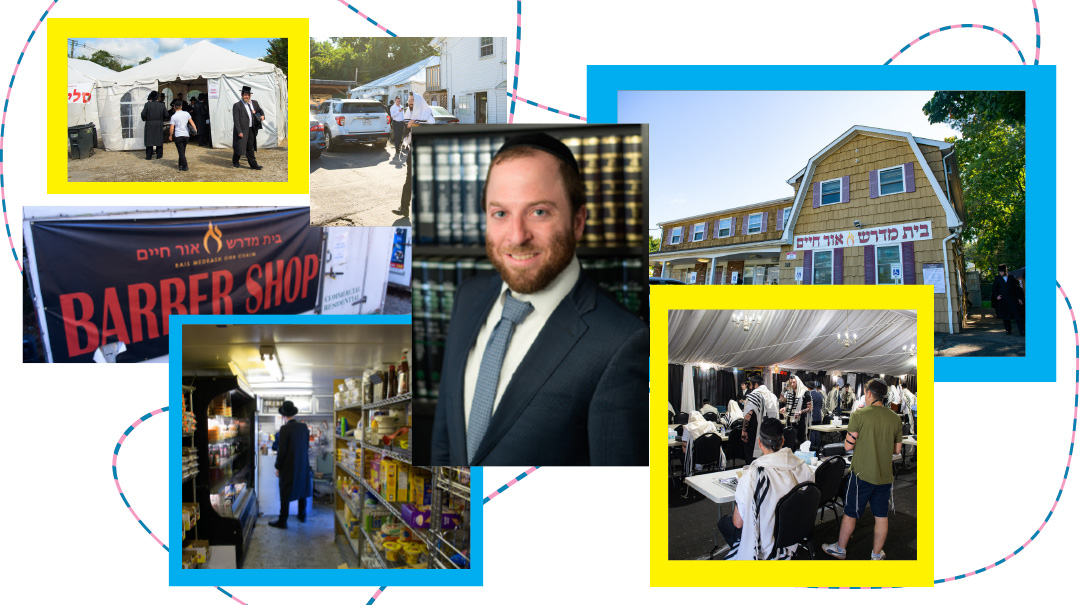
Photos: Naftoli Goldgrab
Three years of misunderstandings and conflict had brought their fair share of tension, but things had come to a head with this latest clash. With one last glare at his parents, Avi stormed out of the house, slamming the door with such force that the sound still rang in his ears 20 minutes into his aimless drive down the Garden State. He had hit a dead end and he knew it; even rebellion had lost its thrill.
He exited the Garden State South and circled back onto the Garden State North; there was nowhere to go, but he might as well return to Monsey. It was close to midnight, and his hometown felt safer than the highway, even if he couldn’t face home itself. He cruised aimlessly down Route 59, not sure how to proceed, when he realized where he could go. With a slight surge of energy (was it hope?) he hung a right off Route 59 onto Saddle River Road, a left on Maple, another left on Viola, and then a right on Forshay Road.
It was past midnight when Avi pulled into the enormous, unpaved parking lot at 18 Forshay, but the crowds were still coming, heading over to the cluster of unassuming white tents. Avi joined them; he wasn’t going to daven like they were, but it felt good just to be there. He leaned against a wall, staring into space, trying, as he had for years, to figure it all out.
Suddenly, there was a tap on his shoulder.
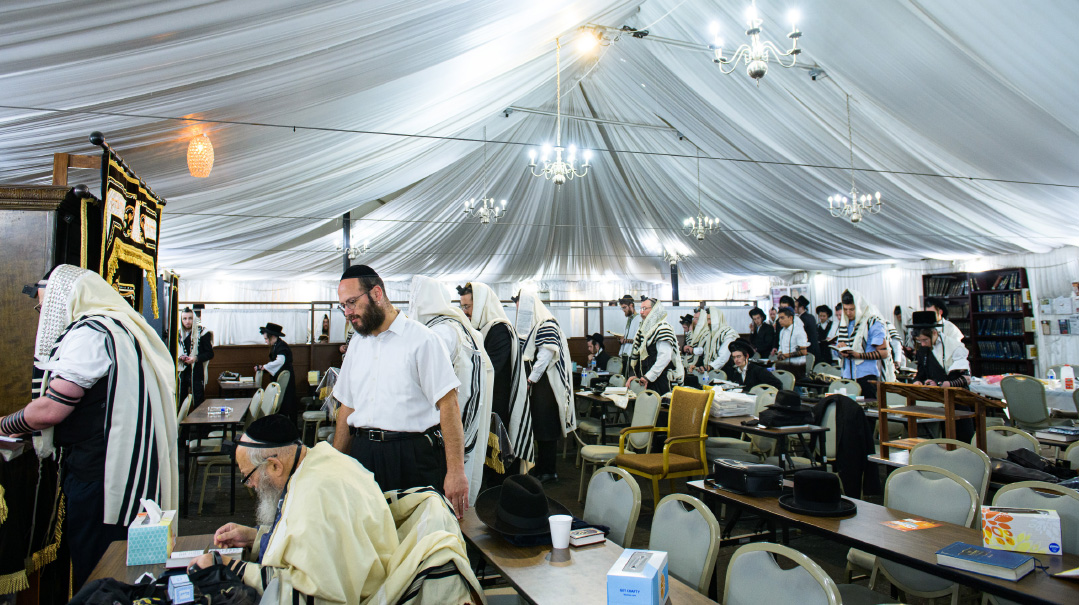
Scheiner’s. Of course I’d heard of it. It was the minyan factory in Monsey, housed in a group of tents, with endless flows of people coming in and out at all hours. Would I want to write an article about Scheiner’s? Uh, I guess so, but I’ll admit I was skeptical. Minyan factories aren’t much of a novelty anymore — would this one really be any different?
But the skepticism began to dissipate as I spoke to multiple people, hearing such superlatives as “one of the holiest places outside of Eretz Yisrael”; “a taste of the Kosel”; and as one avid mispallel put it, “When Mashiach comes and we’ll see Yidden from all walks of life joining together, we’ll look around and say ‘Ah, it looks just like Scheiner’s.’ ”
But hearsay alone wouldn’t cut it. I’d have to experience it myself, observe the routine and soak in the atmosphere. I don’t live in Monsey, so when I show up early one morning at Scheiner’s for Shacharis, I’m schlepping a carry-on and feeling tired and self-conscious. I’m standing outside a tent, unsure what to expect, when a young fellow greets me, sporting the warmest smile. “Looking for a minyan?” he asks. “The seven o’clock is starting right now.”
Encouraged by the warm reception, I daven and head out of the tent, fielding a whole bunch of more “good mornings” as I set out to discover the secret of Scheiner’s.
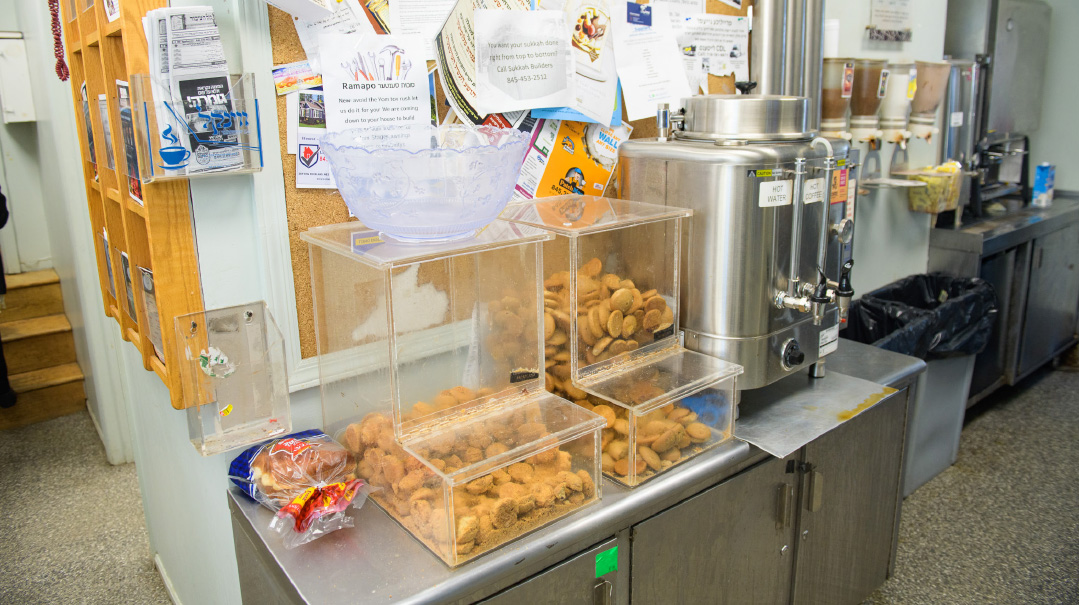
Avi looked up, startled. Standing beside him was a short, slim fellow with a straggly beard and outdated glasses that insisted on sliding down his nose no matter how many times he tried pushing them back up.
“Uh, shalom, shalom,” he said nervously, and Avi raised an impatient eyebrow. This guy reminded him of his tenth-grade rebbi, and there was nothing pleasant about that memory.
“No, stam,” the guy continued. “You just looked a shtickel down. I was wondering if there’s anything I could do to help.” Avi counted to three, waiting for the geyser of fury in him to erupt, and was surprised when it didn’t come. Something about this stranger-turned-eager-mentor was endearing. For no understandable reason Avi thought he even liked him.
“Yeah,” he sighed heavily, “it’s a long story. Been going on for years. You got time?”
“Avadeh,” the mystery man said. “You mind if I chap a Maariv first? We’ll schmooze after, b’seder?”
“Sure, sure, take your time, I’m not going anywhere.” Avi leaned back against the wall and pulled out an e-cigarette. The fellow halted.
“You davened already?”
Avi tried to snort but the sound got stuck in his throat. So he feigned a cough and croaked out, “Oh, yeah, I forgot.”
And for the first time in months, Avi davened Maariv.
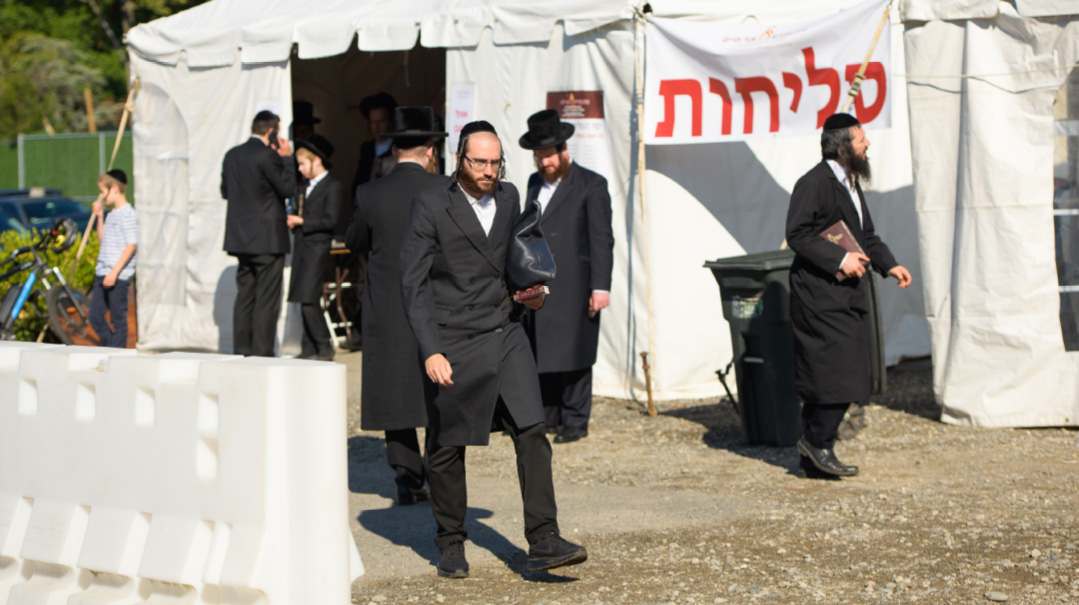
The geographical layout of Scheiner’s can be best described as a campus, albeit an eclectic one at that. There are four tents, numbering “alef” through “daled,” as well as two homes, respectively addressed 18 Forshay and 20 Forshay, which now operate as batei medrash. There’s a mikveh, a keilim mikveh, and three trailers, one of which functions as a grocery store, one as a barber shop, and one as a sofer’s workroom.
Rabbi Nochum Scheiner is the shul’s rabbinical coordinator, and in our phone call prior to my visit, he gives me a brief overview of how the bursting enterprise evolved and what his particular role entails.
“It was about ten years ago when I got a call from my uncle. At the time, he owned the house at 18 Forshay Road, and it was used for a Shabbos minyan. But he wanted to expand it to include a night kollel, and asked me if I would be interested in running it.”
Reb Leizer Scheiner, Reb Nochum’s uncle, is a name synonymous with philanthropy of historic proportions. There’s no easy way to enumerate the sheer number of causes Reb Leizer supports, but a theme that’s uppermost on his list of priorities is achdus. Presumably, it was with this ideal in mind that he propelled what began as a small night kollel into the behemoth minyan factory and bastion of unity that it is today.
“I accepted the position and the night kollel was baruch Hashem very matzliach,” Reb Nochum continues. “We learned halachah, and then had programs that taught the kollel members how to put the material studied into practice. Whether it was hilchos tzitzis, shofar, or milah, we would bring in experts in those fields and have hands-on demonstrations, watching as the simanim in Shulchan Aruch came alive in a way that was tangible and relatable.” The kollel’s reputation grew and soon many community members who weren’t official members of the kollel began to attend.
And when you have a group of men learning together at night, well, it’s inevitable that they’ll want to daven Maariv together.
“We began davening Maariv after seder, simply because it was convenient,” Reb Nochum says easily. It was the first weekday minyan in what would eventually become one of the world’s largest minyan factories.
The night kollel’s success spurred Reb Leizer Scheiner to do more.
“My uncle then decided that he wanted to add a kollel boker before Shacharis,” Reb Nochum continues. This kollel was also run under Reb Nochum’s auspices and it too began to grow in the broader community. More community members began frequenting the morning kollel too, which also focused on halachah.
Naturally, the kollel boker led to a demand for a Shacharis minyan, and this soon became a Scheiner’s feature as well.
“Actually,” Reb Nochum points out, “we didn’t always have a minyan. We had to pay people to come.” But that problem petered out as the kollel boker’s popularity spread.
Never one to rest on his laurels, Reb Leizer continued expanding his new enterprise, instituting a kollel bein hazmanim as well as one for legal holidays, with Reb Nochum supervising these kollelim, too. These in turn beckoned minyanim and pretty soon, a bona fide minyan factory began taking shape. And that necessitated more space.
Reb Laizer purchased a few adjoining properties where four large tents were erected, labeled “alef” “beis,” “gimmel,” and “daled,” with each hosting running minyanim throughout the day. The complex also contains two actual houses, 18 and 20 Forshay, which house the learning programs. Another several properties were purchased across the street to provide adequate parking for the thousands of daily visitors.
There are Shabbos and Yom Tov minyanim as well, but those are smaller, and they’re obviously limited to those within walking distance.
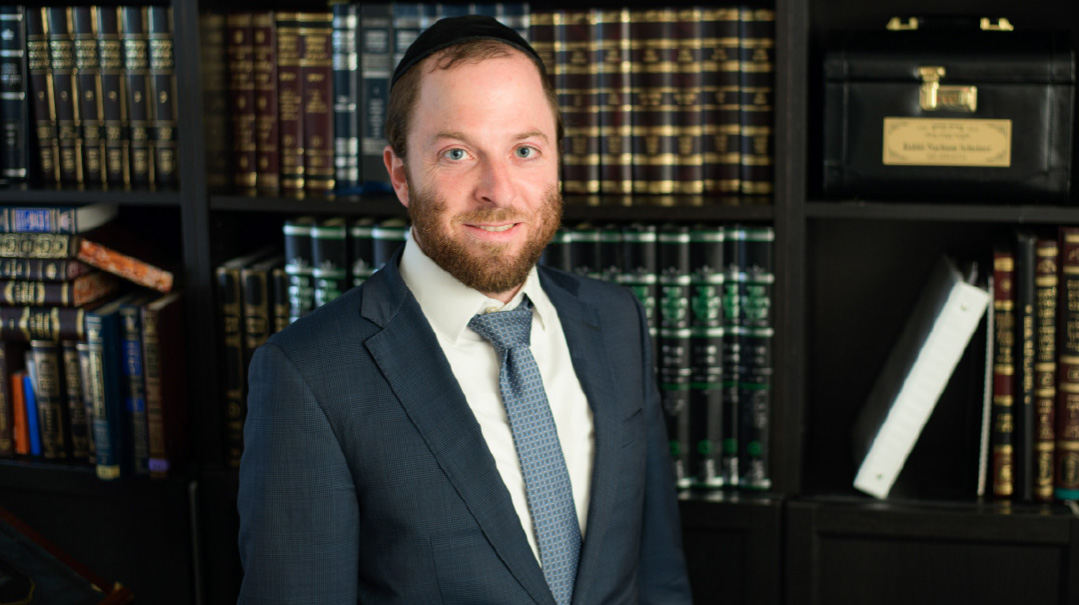
Rabbi Nochum Scheiner, the rabbinic coordinator of his uncle Leizer Scheiner’s burgeoning minyan factory and chesed tents, admits that in the beginning, they had to pay people to come make a minyan
Reb Nochum has definitely piqued my interest, and I’m eager to see it all for myself. After davening, I head up the stairs to the second floor of 18 Forshay, where I’m told there is a beis medrash open and operating 24 hours a day. All are welcome to come and learn in whatever format they choose, but there are a few structured kollelim as well. At the coffee station right outside the beis medrash I meet two fellows who introduce themselves as Moishy and Zev. They’re chavrusas, they tell me, and they’re on their way out, but they stop for a minute to talk.
“I’m actually a bochur,” says Moishy. “I learn here early in the morning before going to yeshivah. I don’t know of any other kollel that welcomes bochurim, but here it’s a non-issue.”
Then I turn to Zev. With his contemporary dress, he gives off a very different look from that of his yeshivah bochur chavrusa.
“I work as a property manager,” he tells me. “But I love starting off my day learning here.” Zev knows that there are many morning kollelim with learning programs for balabatim but he sees something different about Scheiner’s.
“The typical kollel has a group of avreichim whose job is to learn with balabatim,” he says. “But here, I feel like an avreich myself. I’m just as much a part of it as anyone else.”
And this, as I’ll come to learn, is at the heart of the Scheiner’s philosophy, the secret sauce sparking its widespread affection and popularity. In Scheiner’s, everyone is welcome. It’s a key component of their modus operandi.
Uri Follman serves as Scheiner’s’ general manager. “We have a siddur here for every single nusach,” he tells me. “We want the chassid, the Yekkeh, the Sephardi, and the litvak all to be able to daven from the siddur they are most comfortable with.”
But simply ordering Eidot Hamizrach siddurim isn’t enough. It needs to be tailored to the specific nuance of the various branches of Sephardi tradition.
“Reb Leizer Scheiner will walk in and say ‘I don’t see a Moroccan siddur. We need to order Moroccan siddurim .’”
I sense the admiration in his voice as he mentions his employer’s name. As the shul’s general manager, he gets to see its benefactor’s magnanimity up close and the sense of awe is real.
“A few days before Yom Kippur, Reb Leizer called me and said he wants to promote the mitzvah of achilah on Erev Yom Kippur. I had two days to put it all together. We ordered mass amounts of foods and opened our doors to anyone who wished to partake in this once-a-year mitzvah. Over two thousand people came, and there was enough for everyone.”
It’s no wonder that although the shul’s official name is “Ohr Chaim,” the minyan factory is ubiquitously known as “Scheiner’s.” As Reb Leizer Scheiner’s brainchild, or heartchild, its very pulse beats to the tune of his singular generosity.
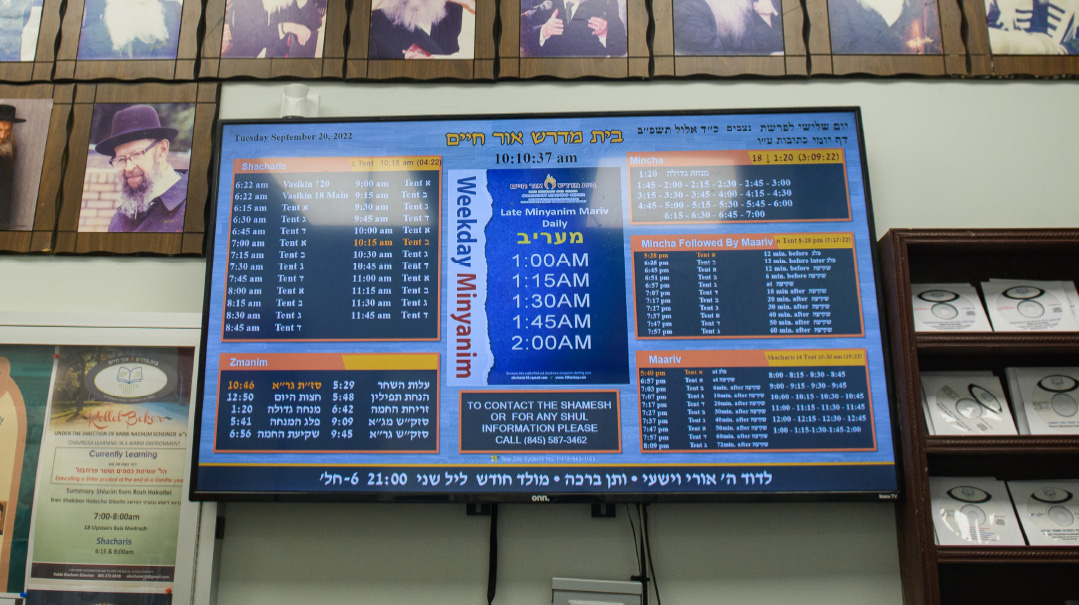
The Scheiner’s operation is designed to make visitors feel welcome. There’s music playing all the time, and cookies and coffee always available. And there’s soup. The most inviting smell wafts from huge pots of bubbling soup, the warm, embracing scent enveloping the entire atmosphere. And the people feel it. Frequent visitors develop a natural desire to be as welcoming as possible, as if the unbridled chesed that served as the impetus for the shul’s creation has embedded itself into the very fabric of its environment.
The shul’s gabbai, Reb Mordechai Pinkesz, is a prime example. Reb Mordechai, or “Reb Motche” as he’s called, has a busy job. He circulates in every single Shacharis minyan, making sure it starts on time, aliyos are sold, and that all runs smoothly. Seeing that the Shacharis minyanim begin at vasikin and then run every 15 minutes, it’s no small task. Still, the perennial smile attached to his face exudes only joy — and even his mode of transportation bespeaks upbeat positivity.
“Running around from minyan to minyan was hard on my feet,” he says cheerfully, “so the shul bought me a Segway.” He’s a pro on the Segway, gracefully gliding between the crowds, screeching to a halt to provide assistance when needed, and then riding on while still greeting people with the infectious smile.
Reb Motche loves his job but is also acutely aware that he carries a crucial responsibility. He shares a chilling story.
“A few weeks ago, I was in a store, about to check out a few items. Suddenly, a chassidish yungerman rushes over and says, ‘Stop! Did you pay yet?’ When I assured him that I hadn’t, he quickly ran to the shelves, pulled off dozens of food items, and threw them in a shopping cart. He then approached the cashier, paid some $200, and handed the whole cart of shopping bags to me. I was utterly baffled by what was going on.
“Then the fellow explained. ‘A while back, I was going through a terrible challenge. I was miserable to the point that I was contemplating taking my life. I showed up to Scheiner’s one day and you greeted me with such a warm smile. That smile lit up something inside me — it gave me the strength to continue. I owe you my life. This is the least I can do to repay you.’”
It’s a story that personifies Scheiner’s message.
Reb Motche loves making people happy, considering it part and parcel of his job. “Beginning on Chodesh Adar, I wore a different hat on each day of the month,” he grins, “and on Shushan Purim, I wore a litvish hat.” We’ve got a way to go until Shushan Purim but, thankfully, there were pictures. The very chassidish Mordechai Pinkesz sporting a Borsalino could make anyone dissolve into uncontrollable laughter.
The attitude of lending a helping hand whenever possible isn’t limited to the administration; it trickles down, and every regular visitor to Scheiner’s seems to have been influenced. One mispallel tells me of a time when he saw a fellow collecting money, explaining he needed food for Shabbos. A young chassidish boy, not even bar mitzvah age, didn’t contribute any money but had something else to offer. “Why don’t you come to our house for Shabbos?” he said.
Zev, the property manager I’d met at the kollel earlier, had also shared a story with me.
“Two years ago, I had just gotten married and had landed a job which I needed to support myself and my wife,” he said. “But then Covid hit and I lost my job. I was really down, and I headed to Scheiner’s. I somehow knew I would have a yeshuah here. I struck up a conversation with someone and told him about my situation. I mentioned that I’m interested in property management and he pulled out his cell phone. He dialed, spoke briefly to whoever was on the other line, and then looked up. ‘Okay,’ he said. ‘You have an interview tomorrow.’ And that’s how I got my current job.”
It’s these kinds of stories that make you realize that something special is happening here. As the throngs continue entering the tents, I’m struck by the thought that my last hands-on encounter with a tent might have been in kindergarten. It wasn’t really a tent, it was popsicle sticks and too much glue, but it was parshas Vayeira that week — when we learned about a man named Avraham Avinu, who had a tent that was open to all, who loved inviting guests and doing whatever chesed he could possibly do for them.
I looked at those tents and marveled and thought back to Zev’s story.
“Okay, you have an interview tomorrow.”
It was the kind of thing Avraham Avinu would do.
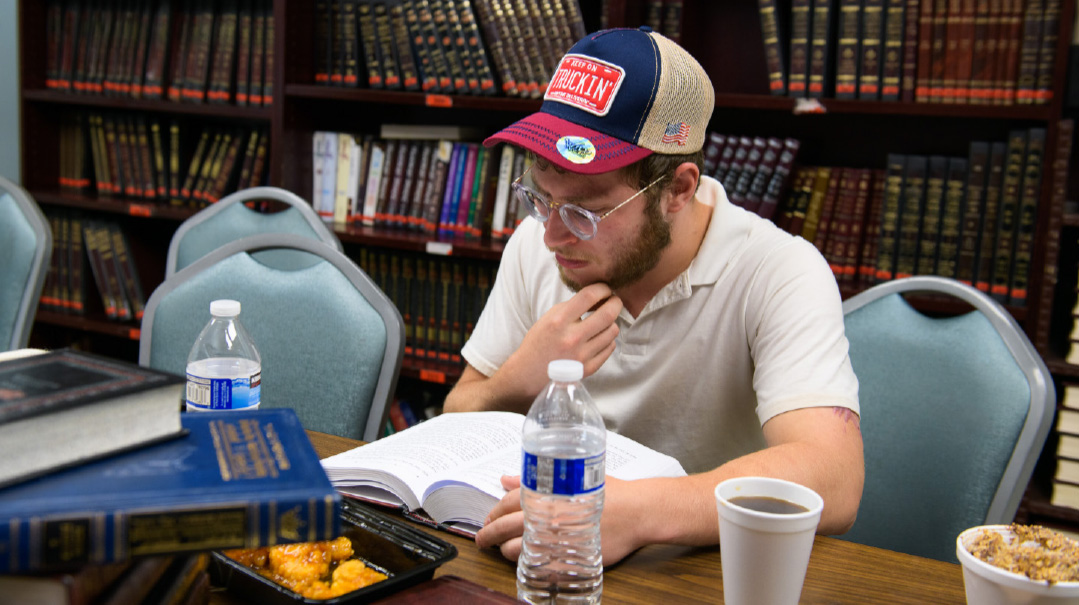
As long as Yaakov Avinu’s children are busy learning Torah, he too lives on
Had Avi thought to ask, he would have learned that his newfound, straggly bearded friend actually had a name — Yechezkel. And had he thought to ask, he would have learned that Yechezkel had a story of his own.
He had been a ninth-grade rebbi in a popular yeshivah, and he loved his job. He loved learning, loved teaching, loved connecting with his students. But then a new menahel joined the yeshivah, with some impressive credentials — a social work degree from Columbia or something. In his vast wisdom and understanding of today’s teenagers, he decided that Yechezkel wasn’t “contemporary enough to relate to their struggles and challenges.” Those were his words, and he said them with such rehearsed sympathy he may as well have read them off an index card.
Yechezkel had never hurt anyone in his life, yet it took all his willpower not to slug the guy in his smug, well-educated face. But he held his head high, said he fully understood, gathered his belongings, headed home, threw himself on his bed, and cried harder than he imagined possible. While the obvious next step would be to apply for a position in another yeshivah, he simply couldn’t. Something in him had died the day he was sent packing.
Yechezkel had an uncle who ran an Amazon business along with a warehouse, and he offered his nephew a managerial position which he accepted. When people asked him how it was going he said things were great. It was a lie, though. Things were terrible and he was miserable.
When concerned friends recommended therapy, Yechezkel wanted to scream. “I don’t need therapy! All I need is to be a rebbi again!” But he said nothing, just shrugged and continued staring into space.
One day, he absently opened a Chumash to the end of parshas Toldos (24:63), right before Yitzchak meets his wife, Rivkah, for the very first time. “Vayeitzei Yitzchak lasuach basadeh — And Yitzchak went out to the field,” the words read. Yechezkel continued scanning the page, and he caught sight of the Kli Yakar. Yitzchak wasn’t merely strolling, the Kli Yakar comments, rather the Gemara explains that he was davening. Presumably, says the Kli Yakar, Yitzchak was davening to find his shidduch and, sure enough, almost immediately, he sees Rivkah.
Something stirred inside Yechezkel, a little something that had been hibernating for months. I need to daven, he thought urgently. Maybe if I daven I’ll have a yeshuah.
He reached for his hat, jacket, and car keys in a single Olympian sweep and dashed out the door. He knew exactly where he was going. He didn’t daven in Scheiner’s often but, when he did, it always felt special. There was something there that made davening easy. Maybe it was the unity, maybe it was the simplicity, or maybe it was just the power of having so many tefillos gathered under the same roof. Either way, Yechezkel knew 18 Forshay was where he had to be.
About to begin davening, he noticed a boy, leaning against a wall, the expression on his face painfully familiar. Depression — it was an easy diagnosis. But ironically, though Yechezkel knew these dark depths intimately, the weight inside him began to lift. In this boy, he saw a mission, and he saw hope — for both of them.
Approaching the boy, he started ad-libbing, so nervous he forgot to share his own name. To his delight, the boy was willing to talk to him, willing to be the talmid he so craved to have. Yechezkel knew this was the yeshuah he was seeking.
He wanted to pursue the conversation immediately — Maariv could wait. Then he remembered the words of the Kli Yakar. “Daven first,” he told himself, “you’ll schmooze later.” And Yechezkel smiled.
It was the kind of thing Yitzchak Avinu would do.
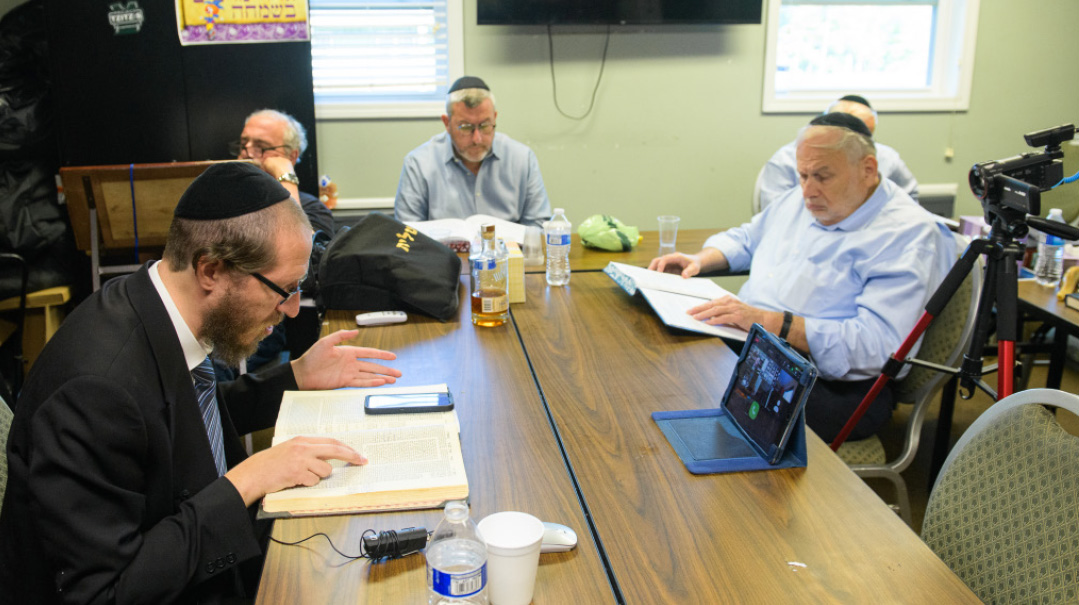
Interwoven throughout the shouts of prayer and myriad acts of chesed is another ripple of energy coursing through the shul’s character, completing the triangle upon which it was founded. Torah. Scheiner’s is full of Torah. Throughout the day, its batei medrash are open and there is a constant hum of the universe’s most beautiful song.
A multitude of shiurim are given daily in an impeccably organized schedule. The lineup of maggidei shiur is too long to list, but so much of the learning can be credited to the leading team of rabbanim: Rabbi Aron Lankry, head rabbi; Rabbi Daniel Coren, associate rabbi; Rabbi Yitzchok Silber, rosh kollel of a chasidishe kollel; and Rabbi Nochum Scheiner, who, in addition to being rabbinic coordinator, also holds the title of rosh kollel.
These rabbanim are always available, ready to provide halachic guidance, practical advice, or just a sympathetic ear to anyone in need. In addition to the rabbanim, there are formally hired maggidei shiur: Rabbi Simcha Bunim Berger, Rabbi Yitzchok Silber and Rabbi YY Jacobson.
But this doesn’t even tell half the story. Multiple maggidei shiur deliver numerous shiurim throughout the day. Scheiner’s has daf yomi shiurim delivered in English, Yiddish, and Hebrew, and a special “Daf and Guitar” shiur by Rabbi Daniel Coren. There is a Zera Shimshon chaburah, a Mishnah Berurah shiur, a Chovos Halevavos shiur, a Mishnah Yomi shiur, a daily shiur in Yerushalmi, a Thursday night mishmar shiur, a Sunday morning Nach shiur, a hilchos shechitah shiur, an Ohr Hachaim shiur, a Chofetz Chaim shiur, a Kol Hane’arim program, a bein hazmanim program, and a legal holiday program as well as many more.
Rabbi YY Jacobson is a regular Scheiner’s lecturer, delivering a daily shiur in chassidus as well as several other popular shiurim during the week.. He also leads one of the Shabbos minyanim.
Since I’m only here for the day, I cannot possibly observe this plethora of shiurim in action. The best I can do is stand outside the beis medrash located on the top floor of 18 Forshay and watch. The crowd learning inside is diverse, which, at this point, I’d come to expect. There are chassidim speaking Yiddish and a yungerman tutoring an elementary school student.
There’s a very well-dressed fellow learning with rapt intensity. I watch him stand up suddenly and walk briskly out the door. He’s on the phone, and I hear him issuing instructions. “Tell your attorneys to call our attorneys, and we’ll have that document drafted and sent over.” Then he hangs up the phone and returns to his Gemara. It’s smack in middle of a workday, and he seems smack in middle of a business deal, but here he is, dealing with what’s really important.
After spending some time observing the beis medrash, I head back down to the tent area where I’m greeted, once again, by the gabbai, Reb Mordechai Pinkesz. He leads me down to an office located in 18 Forshay’s basement, where we meet up with Uri Follman, general manager, and Akiva Pollack, director of development. They introduce me to the immense amount of programming happening at Scheiner’s and the intricate details involved.
“Basically,” Uri tells me, “any aspect of Yiddishkeit you might be looking for is available here.”
I don’t need to rely on their testimony — they have plenty of pictures to back them up. They recently ran a massive tefillin-checking program, where 14 sofrim were on call to check people’s tefillin and ensure that they meet the highest level of hiddur.
Leading up to Yom Kippur there are chickens and roosters available for kapparos, and right beside it, a small kiddie pool with fish where people can say Tashlich. Before Succos arba minim are sold, and before Pesach there is an industrial-sized pot for hagalas keilim.
It’s an impressive display of wide-ranging programming but, if I understand it correctly, it’s all with a single-minded mission: to bring Torah to life. In Scheiner’s, Torah is studied, taught, and cherished, but then it continues to spread, long after the Gemaras are closed. It sparkles from the fresh coat of ink applied to the old pair of tefillin. It bubbles from the steaming pot cleansing dishes from their chometz. It gleams from the beauty of brand new esrogim, and it revels in the children delighted by the sight of fish swimming in a kiddie pool.
In the complex of humble white tents known simply as “Scheiner’s,” Torah is flourishing, so real and alive, you can touch it, see it, and, inevitably, love it.
When the Kotzker Rebbe once conducted a farher in a children’s cheder, he pointed to one boy and asked him to read a pasuk. It was a pasuk that told of the length of a certain individual’s lifespan, and the boy chanted in the traditional singsong, “Vayechi — and he lived… vayamas — and he died.” But the Kotzker stopped him, shaking his head. “That’s not how you read it,” he said to the confusion of the class and even their rebbi.
Instead of explaining, the Kotzker stood before the class and roared “Vayechi — Uhn ehrhut gelebt (And he lived)!” Then he lowered his voice to a hush, “Vayamas — Uhn her hut geshturben (And he died).” Life is not something to be chanted, the Kotzker was telling them. It’s something to be roared, imbued with as much energy, as much color, and as much vitality, as possible.
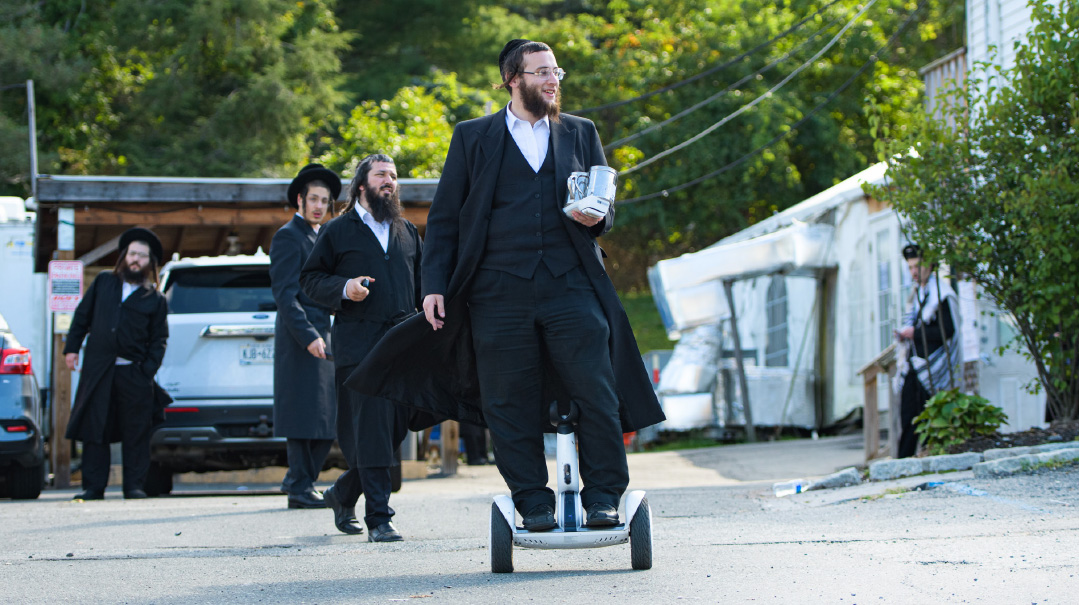
Reb Motche, on his trademark Segway, gracefully glides between the crowds, making people happy
Who lived this ideal more than Yaakov Avinu? Yaakov Avinu lo meis, the Gemara in Taanis (5b) tells us that Yaakov Avinu never died. And the Gemara explains: Mah zaro b’chayim, af hu b’chayim — so long as his children are alive, he too is alive.
The pictures of people clutching their tefillin, the throngs gathering for kapparos, the kiddie pool for Tashlich… they all tell the same story: It’s a story of vibrancy, it’s a story of life itself. Vayechi Yaakov — through his children, Yaakov lives on.
I leave the office and head back outside, this time struck by yet another irony of the tents:
“V’Yaakov ish tam yosheiv ohalim.” (Bereishis 25:27). Torah-filled tents are well-precedented. Scheiner’s might be the only place today where the combination is current, but they have a wonderful example to look back on.
It’s the kind of thing Yaakov Avinu would do.
And Avi and Yechezkel? They’re like people and so many other stories.
“This is a place where everyone will help you,” says one mispallel. “Here, there is no such thing as machlokes,” says another. “My Rosh Yeshivah, who is not from Monsey, was here for a chasunah,” someone else tells me. “He davened in Scheiner’s and commented to me that he felt so comfortable here.”
“Sometimes I come here at night and see some teenagers who can use some chizuk. I try to do what I can for them,” yet another mispallel shares, and then another tells me that “I once saw three boys pull into the parking lot right before shkiah. They rapidly pulled their tefillin out of the trunk and put them on right before the zeman. They wanted to perform the mitzvah but recognized that by doing so at the day’s end, they’d be exposing their negligence. But in Scheiner’s, they knew no one would judge them.”
Roshei yeshivah. Struggling teens. People from literally every walk of life. What is the attraction? What is the secret? What is the hidden power of Scheiner’s?
The Gemara in Bava Metzia (85b) tells us that even today, Avraham, Yitzchak, and Yaakov daven from their place in the Mearas Hamachepeilah. They each take turns, however, because, should they pray simultaneously, the impact would be too powerful — it would compel Mashiach to come before the proper time.
When the three Avos come together, amazing things can happen.
Hundreds visit Scheiner’s every day, to daven, to learn, to offer or receive endless generosity. From the outside, the tents seem simple but those on the inside know that they aren’t. They’re bastions of spirituality, the very pillars upon which the world stand. Within them reigns the chesed of Avraham, the avodah of Yitzchak, and the Torah of Yaakov. And it’s against this backdrop that thousands of tefillos ascend Heavenward, propelled by the force of this patriarchal fusion.
And maybe that’s the secret power of Scheiner’s.
Because when the three Avos come together, amazing things can happen.
(Originally featured in Mishpacha, Issue 941)
Oops! We could not locate your form.







